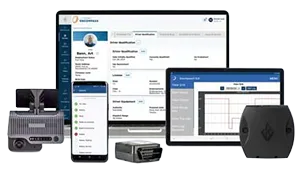Your PSP Report Shows Future Employers How Safety-Conscious You Are
Written by Kathy Close, J. J. Keller Editor
For a number of years, motor carriers have used the screening tools required under the Federal Motor Carrier Safety Regulations (FMCSRs) — the motor vehicle report (MVR), Safety Performance History inquiry, and road test — to consider potential drivers.
Now motor carriers have yet another means of vetting commercial drivers — the Pre-employment Screening Program (PSP). The Federal Motor Carrier Safety Administration (FMCSA) has recently provided this "optional" background investigation to motor carriers for consideration.
Who has access?
This new database has many drivers concerned about who will see their records. According to the FMCSA, any motor carrier — or party that screens new drivers on their behalf — may use this data clearinghouse. Drivers have been assured by FMCSA that insurance companies and other interested parties will not have access.
The term "driver" encompasses more than just company employees. Motor carriers may request PSP reports on leased owner-operators and drivers from staffing services. In addition, motor carriers cannot request a PSP report on existing drivers. PSP is strictly used in making a hiring decision.
When using PSP, parties must first obtain a signed release from the driver. Since the data is managed by an FMCSA vendor, acting as a data clearinghouse, motor carriers and others who screen drivers must provide applicants all required Fair Credit Reporting Act paperwork.
Motor carriers using the database must first subscribe to the service and then pay a per-records request fee. Drivers may request a copy of their own PSP report by just paying the records request fee of $10 (no subscription fee is necessary). They also have the option of going to the FMCSA directly for a free copy by submitting a Privacy Act request.
MCMIS data
Most data contained in the PSP driver report is not found in any other single source. Information originating in the Motor Carrier Management Information System (MCMIS) is used to populate the report.
Federal and state enforcement personnel enter the details of roadside inspections, crash reports, and investigations into MCMIS. Based on these entries, a prospective employer is able to see the past 3 years’ worth of roadside inspection violations and 5 years’ worth of DOT accident history (i.e., those accidents appearing on the DOT accident register). It is important to note that unless a roadside inspection violation translates into a traffic conviction appearing on an MVR, the event will not be discovered through traditional inquiries. Keep in mind that PSP does not replace any existing checks mandated by FMCSA. It is going above and beyond the FMCSRs.
As you may recall, MCMIS also funnels data to the Safety Measurement System (SMS) under the Compliance, Safety, Accountability (CSA) program. However, drivers will not be scored in the PSP as they are in the SMS. Prospective employers will not have access to a driver’s CSA scores. In fact, no one except enforcement personnel will see scored data in the SMS.
Report content
The report itself includes a driver’s personal information, such as complete name, driver’s license number/state of issue, and date of birth. The PSP report is broken down into Crash and Inspection Activity.
Crash Activity compiles overall statistics about the accidents listed:
- Total number of crashes,
- Total crashes with fatalities,
- Total crashes with injuries,
- Total crashes with towaways, and
- Total crashes with a hazmat release.
- Each accident is then summarized. Basically, each entry contains the information appearing on the actual crash report: date, reporting state, crash report number, location, and USDOT number under which the event took place.
Similar details are released for the roadside inspections under Inspection Activity. A high-level look summarizes the driver, vehicle, and hazmat inspections. Readers see the number of inspections for each category, number of Out-of-Service Inspections, and Out-of-Service Rate (percentage) for each, respectively.
As with the accident information, each roadside inspection report is detailed. The PSP report shows the date, USDOT number and carrier name under which the driver operated, reporting state, report number, if a hazmat inspection was included, the level of inspection, and the number of violations cited for that specific roadside inspection. This is very similar to the carrier view in the SMS.
The final entry on the PSP report is a summary of the driver’s roadside inspection violations by regulation, a description of the violation, number of times the driver violated this regulation in the past 36 months, and number of times the violation resulted in an out-of-service order.
Challenging incorrect data
Drivers are encouraged to request a copy of their PSP report for review. If a driver finds that a violation or accident is not his or hers, or the details of a specific accident or roadside inspection are inaccurate, the driver would have to challenge the entry via FMCSA’s DataQs web portal.
This is important for two reasons:
- First, the information presented in PSP affects your ability to find a future driving position, and
- Second, these same statistics are used when calculating a driver’s SMS BASIC scores under CSA.



